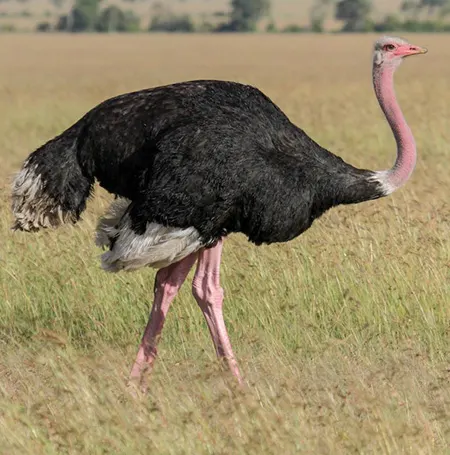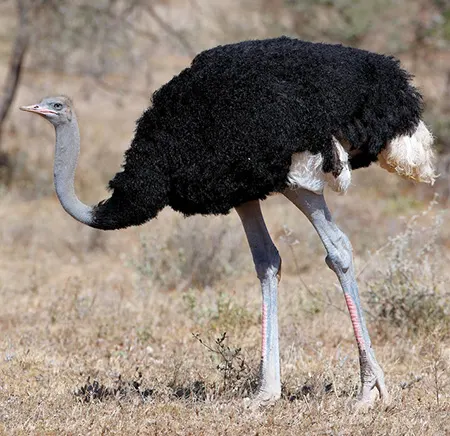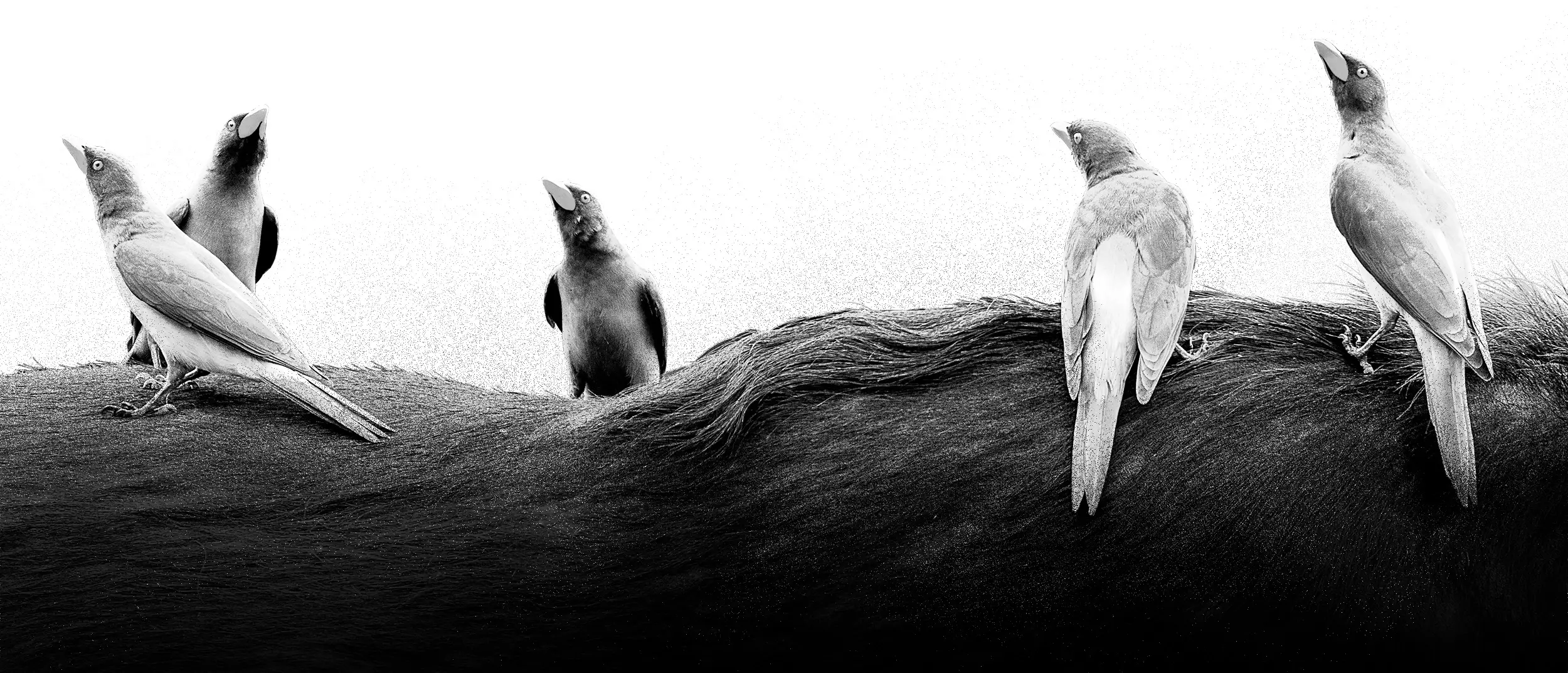
(Struthioniformes)
Ostriches
Страусові
Ostriches are large flightless birds. Two living species are recognised, the common ostrich, native to large areas of sub-Saharan Africa, and the Somali ostrich, native to the Horn of Africa.
The ostrich is the tallest and heaviest living bird. Males stand 2.1 to 2.75 m tall and weigh 100 to 130 kg, whereas females are about 1.75 to 1.9 m tall and weigh 90 to 120 kg. While exceptional male ostriches (in the nominate subspecies) can weigh up to 156.8 kg, some specimens in South Africa can only weigh between 59.5 to 81.3 kg. New chicks are fawn in color, with dark brown spots. After three months they start to gain their juvenile plumage, which is steadily replaced by adult-like plumage during their second year. At four or five months old, they are already about half the size of an adult bird, and after a year they reach adult height, but not till they are 18 months old will they be fully as heavy as their parents.
Behaviour
Ostriches normally spend the winter months in pairs or alone. Only 16 percent of ostrich sightings were of more than two birds. During breeding season and sometimes during extreme rainless periods ostriches live in nomadic groups of five to 100 birds (led by a top hen) that often travel together with other grazing animals, such as zebras or antelopes. Ostriches are diurnal, but may be active on moonlit nights. They are most active early and late in the day. The male ostrich territory is between 2 and 20 km2.
With their acute eyesight and hearing, ostriches can sense predators such as lions from far away. When being pursued by a predator, they have been known to reach speeds in excess of 70 km/h, or possibly 80 km/h and can maintain a steady speed of 50 km/h, which makes the ostrich the world’s fastest two-legged animal. When lying down and hiding from predators, the birds lay their heads and necks flat on the ground, making them appear like a mound of earth from a distance, aided by the heat haze in their hot, dry habitat.
When threatened, ostriches run away, but they can cause serious injury and death with kicks from their powerful legs. Their legs can only kick forward.The kick from an ostrich can yield 225 kgf.
Feeding
They mainly feed on seeds, shrubs, grass, fruit, and flowers; occasionally they also eat insects such as locusts, small reptiles such as lizards, and animal remains left by carnivorous predators. Lacking teeth, they swallow pebbles that act as gastroliths to grind food in the gizzard. When eating, they will fill their gullet with food, which is in turn passed down their esophagus in the form of a ball called a bolus. The bolus may be as much as 210 mL. After passing through the neck (there is no crop) the food enters the gizzard and is worked on by the aforementioned pebbles. The gizzard can hold as much as 1,300 g, of which up to 45% may be sand and pebbles. Ostriches can go without drinking for several days, using metabolic water and moisture in ingested plants, but they enjoy liquid water and frequently take baths where it is available. They can survive losing up to 25% of their body weight through dehydration.
Mating
Ostriches become sexually mature when they are 2 to 4 years old; females mature about six months earlier than males. As with other birds, an individual may reproduce several times over its lifetime. The mating season begins in March or April and ends sometime before September. The mating process differs in different geographical regions. Territorial males typically boom (by inflating their neck) in defense of their territory and harem of two to seven hens; the successful male may then mate with several females in the area, but will only form a pair bond with a ‘major’ female.
The cock performs with his wings, alternating wing beats, until he attracts a mate. They will go to the mating area and he will maintain privacy by driving away all intruders. They graze until their behavior is synchronized, then the feeding becomes secondary and the process takes on a ritualistic appearance. The cock will then excitedly flap alternate wings again and start poking on the ground with his bill. He will then violently flap his wings to symbolically clear out a nest in the soil. Then, while the hen runs a circle around him with lowered wings, he will wind his head in a spiral motion. She will drop to the ground and he will mount for copulation.
The female ostrich lays her fertilized eggs in a single communal nest, a simple pit, 30 to 60 cm deep and 3 m wide, scraped in the ground by the male. The dominant female lays her eggs first; when it is time to cover them for incubation, she discards extra eggs from the weaker females, leaving about 20 in most cases. A female ostrich can distinguish her own eggs from the others in a communal nest. Ostrich eggs are the largest of all eggs, though they are actually the smallest eggs relative to the size of the adult bird – on average they are 15 cm long, 13 cm wide, and weigh 1.4 kg, over 20 times the weight of a chicken’s egg and only 1 to 4% the size of the female. They are glossy cream-colored, with thick shells marked by small pits.
The eggs are incubated by the females by day and by the males by night. This uses the coloration of the two sexes to escape detection of the nest. The drab female blends in with the sand, while the black male is nearly undetectable in the night. The incubation period is 35 to 45 days, which is rather short compared to other ratites. This is believed to be the case due to the high rate of predation. Typically, the male defends the hatchlings and teaches them to feed, although males and females cooperate in rearing chicks. Fewer than 10% of nests survive the 9-week period of laying and incubation, and of the surviving chicks, only 15% of those survive to 1 year of age. However, among those ostriches who survive to adulthood, the species is one of the longest-living bird species. Ostriches in captivity have lived to 62 years and 7 months.
Predators
As a flightless species in the rich biozone of the African savanna, the ostrich faces a variety of formidable predators throughout its life cycle. Animals that prey on ostriches of all ages may include cheetahs, lions, leopards, African hunting dogs, and spotted hyenas. Predators of nests and young ostriches include jackals, various birds of prey, warthogs, mongoose, and Egyptian vultures. Egyptian vultures have been known to hurl stones at ostrich eggs to crack them open so they can eat their contents.

(Struthio camelus)
Common Ostrich
Страус африканський
Prefer open land and are native to the savannas and Sahel of Africa, both north and south of the equatorial forest zone.

(Struthio molybdophanes)
Somali Ostrich
Страус сомалійський
Is mostly found in the Horn of Africa, especially in north-eastern Ethiopia, southern Djibouti, most of Kenya, and across most of Somalia.

